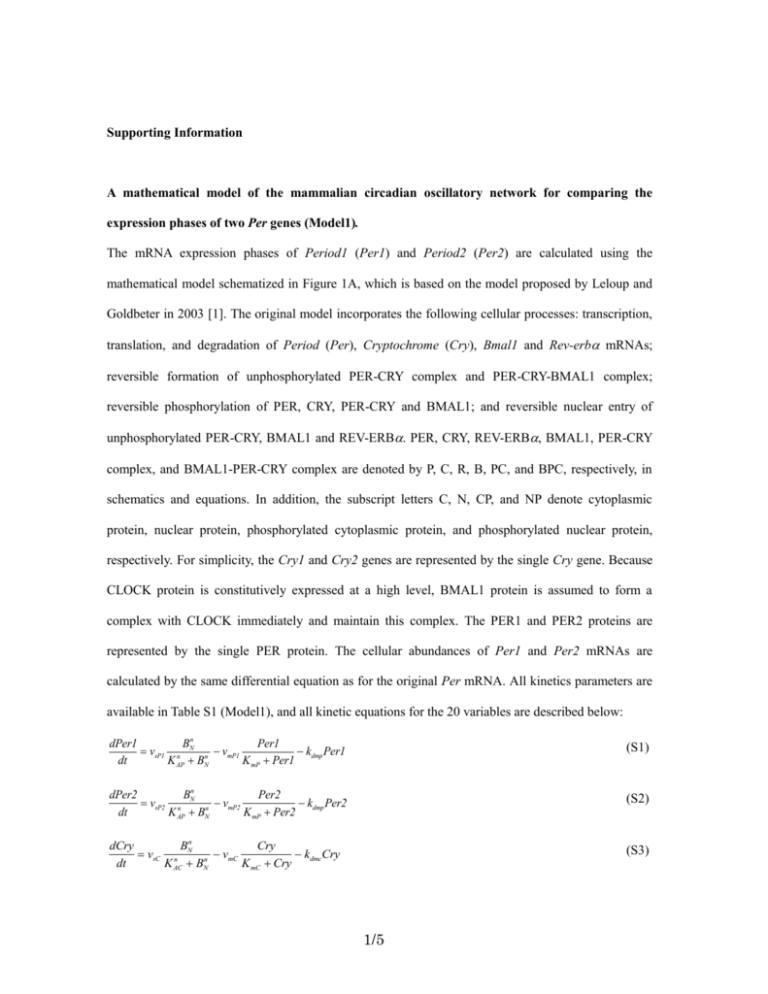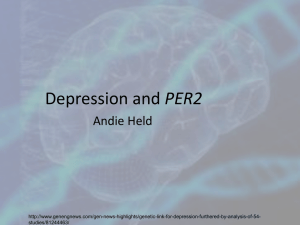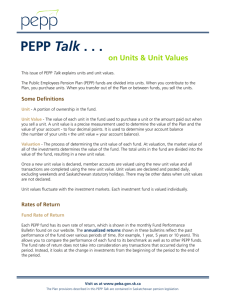Classification: Biological Sciences, Systems biology
advertisement

Supporting Information A mathematical model of the mammalian circadian oscillatory network for comparing the expression phases of two Per genes (Model1). The mRNA expression phases of Period1 (Per1) and Period2 (Per2) are calculated using the mathematical model schematized in Figure 1A, which is based on the model proposed by Leloup and Goldbeter in 2003 [1]. The original model incorporates the following cellular processes: transcription, translation, and degradation of Period (Per), Cryptochrome (Cry), Bmal1 and Rev-erb mRNAs; reversible formation of unphosphorylated PER-CRY complex and PER-CRY-BMAL1 complex; reversible phosphorylation of PER, CRY, PER-CRY and BMAL1; and reversible nuclear entry of unphosphorylated PER-CRY, BMAL1 and REV-ERB. PER, CRY, REV-ERB, BMAL1, PER-CRY complex, and BMAL1-PER-CRY complex are denoted by P, C, R, B, PC, and BPC, respectively, in schematics and equations. In addition, the subscript letters C, N, CP, and NP denote cytoplasmic protein, nuclear protein, phosphorylated cytoplasmic protein, and phosphorylated nuclear protein, respectively. For simplicity, the Cry1 and Cry2 genes are represented by the single Cry gene. Because CLOCK protein is constitutively expressed at a high level, BMAL1 protein is assumed to form a complex with CLOCK immediately and maintain this complex. The PER1 and PER2 proteins are represented by the single PER protein. The cellular abundances of Per1 and Per2 mRNAs are calculated by the same differential equation as for the original Per mRNA. All kinetics parameters are available in Table S1 (Model1), and all kinetic equations for the 20 variables are described below: dPer1 Bn Per1 vsP1 n N n vmP1 kdmp Per1 dt K AP BN K mP Per1 (S1) dPer2 Bn Per2 vsP2 n N n vmP2 kdmp Per2 dt K AP BN K mP Per2 (S2) dCry Bn Cry vsC n N n vmC kdmcCry dt K AC BN K mC Cry (S3) 1/5 dRev - erb Bh Rev - erb vsR h N h vmR kdmr Rev - erb dt K AR BN K mR Rev - erb (S4) dBmal1 Km Bmal1 vsB m IB m vmB kdmb Bmal1 dt K IB RN K mB Bmal1 (S5) dPC PC PCP ksP * (Per1 Per2) k3 PC CC k4 PCC V1P V2P kdn PC dt K p PC K dp PCP (S6) dCC CC CCP ksC * Cry k3 PC CC k4 PCC V1C V2C kdnCC dt K p CC K dp CCP (S7) dPCP PC PCP PCP V1P V2P vdPC kdn PCP dt K p PC K dp PCP K d PCP (S8) dCCP CC CCP CCP V1C V2C vdCC kdnCCP dt K p CC K dp CCP K d CCP (S9) dPCC PCC PCCP k3 PC CC k4 PCC k1PCC k2 PCN V1PC V2PC kdn PCC dt K p PCC K dp PCCP (S10) dPCN PCN PCNP k1PCC k2 PCN k7 BN PCN k8 BPCN V3PC V4 PC kdn PCN dt K p PCN K dp PCNP (S11) dPCCP PCC PCCP PCCP V1PC V2PC vdPCC kdn PCCP dt K p PCC K dp PCCP Kd PCCP (S12) dPCNP PCN PCNP PCNP V3PC V4 PC vdPCN kdn PCNP dt K p PCN K dp PCNP K d PCNP (S13) dRC RC ksR * Rev - erb k9 RC k10 RN vdRC kdn RC dt K d RC (S14) dRN RN k9 RC k10 RN vdRN kdn RN dt K d RN (S15) dBC BC BCP ksB * Bmal1 k5 BC k6 BN V1B V2B kdn BC dt K p BC K dp BCP (S16) dBN BN BNP k5 BC k6 BN k7 BN PCN k8 BPCN V3B V4B kdn BN dt K p BN K dp BNP (S17) dBCP BC BCP BCP V1B V2B vdBC kdn BCP dt K p BC K dp BCP K d BCP (S18) 2/5 dBNP BN BNP BNP V3B V4B vdBN kdn BNP dt K p BN K dp BNP K d BNP (S19) dBPC N BPC N k7 BN PC N k8 BPC N vdIN kdn BPC N dt K d BPC N (S20) A modified mathematical model introduced a nuclear PER and CRY monomer to simulate the expression phase difference between Per1 and Per2 mRNA expressions (Model2). To introduce an additional mechanism of transcriptional regulation by a nuclear PER monomer, several assumptions were introduced to the model described above. The dissociation of the nuclear PER-CRY complex (PCN) was described in the same equation, and parameters such as cytoplasmic PER-CRY (PCC) and nuclear PER (PN) and CRY (CN) were degraded in the same manner as the nuclear PER-CRY complex instead of by the PER-CRY degradation processes. Nuclear CRY associates and dissociates with nuclear CLOCK-BMAL1 (BN) in the same manner as nuclear PER-CRY. Changes in five additionally introduced molecules (nuclear PER (PN), nuclear CRY (CN), nuclear phosphorylated PER (PNP), nuclear phosphorylated CRY (CNP), and BMAL1-CRY complex (BCN)) were calculated by the following equations: dPN PN PNP k11PN CN k12 PCN V3P V4 P kdn PN dt K p PN K dp PNP (S21) dCN CN CNP k11PN CN k12 PCN V3C V4C k13 BN CN k14 BCN kdnCN dt K p CN K dp CNP (S22) dPNP PN PNP PNP V3P V4 P vdPN kdn PNP dt K p PN K dp PNP K d PNP (S23) dCNP CN CNP CNP V3C V4C vdCN kdnCNP dt K p CN K dp CNP K d CNP (S24) dBC N BC N k13 BN C N k14 BC N vdBCN kdn BC N dt K d BC N (S25) 3/5 Accordingly, the kinetic equation of nuclear PER-CRY complex (PCN, Eq. S11) and nuclear BMAL1 (BN, Eq. S17) were replaced by Eq. S11’ and Eq. S17', respectively: dPCN PCN PCNP k1PCc k2 PCN k11PN CN k12 PCN k7 BN PCN k8 BPCN V3PC V4 PC kdn PCN dt K p PCN Kdp PCNP (S11’) dBN BN BNP k5 BC k6 BN k7 BN PCN k8 BPCN k13 BN CN k14 BCN V3B V4B kdn BN dt K p BN K dp BNP (S17’) All kinetics parameters are available in Table S1 (Model2). The Per2 positive feedback regulation model. This model is based on the modified model described above (Eqs. S1-S25) and tests the hypothesis that nuclear PER acts as a positive regulator of Per2 mRNA transcription. The positive feedback regulation of Per2 transcription by nuclear PER (PN) is described in a mass action law. The Per2 mRNA kinetic equation (Eq. S2) is replaced by Eq. S2a: dPer2 Bn Per2 vsP2 n N n kAP2 PN vmP2 kdmp Per2 dt K AP BN K mP Per2 (S2a) where kAP2 denotes a rate coefficient of positive feedback regulation of Per2 transcription by PER. In this model including the positive feedback regulation of Per2 transcription by PER proteins (kAP2 > 0), bistability appeared as the fluctuating orbits kept stable oscillation or converged to a stable steady state depending on the initial values of variables. The Per1 positive feedback regulation model. This model tests the hypothesis that nuclear PER2 acts as a positive regulator of Per1 mRNA transcription. The positive feedback regulation of Per1 transcription by nuclear PER (PN) is described in a mass action law. The Per1 mRNA kinetic equations (Eq. S1) is replaced by Eq. S1a: dPer1 Bn Per1 vsP1 n N n kAP1PN vmP1 kdmp Per1 dt K AP BN K mP Per1 4/5 (S1a) where kAP1 denotes a rate coefficient of positive feedback regulation of Per1 transcription by PER. The circadian oscillations are simulated when kAP1 is a value from 0.01 to 0.92 h-1. The full model is governed by Eq. S1a and Eqs. S2-S25. The Per2 negative feedback regulation model. This model tests the hypothesis that nuclear PER acts as a negative regulator of Per2 mRNA transcription, the negative feedback regulation of Per2 transcription by nuclear PER (PN) is introduced into the original transcriptional term. The Per2 mRNA kinetic equation (Eq. S2) is replaced by Eq. S2b: dPer2 BNn Per2 vsP2 n vmP2 kdmp Per2 n n dt K AP BN (kRP2 PN ) K mP Per2 (S2b) where kRP2 denotes the strength of negative feedback regulation of Per2 transcription by PER. kRP2 can be varied from 0 to more than 10000. The full model is governed by Eq. S1, Eq. S2b and Eqs. S3-S25. The Per1 negative feedback regulation model. This model is governed by tests the hypothesis that nuclear PER acts as a negative regulator of Per1 mRNA transcription. The negative feedback regulation of Per1 transcription by nuclear PER (PN) is introduced into the original transcriptional term. The Per1 mRNA kinetic equation (Eq. S1) is replaced by Eq. S1b: dPer1 BNn Per1 vsP1 n vmP1 kdmp Per1 n n dt K AP BN (kRP1PN ) K mP Per1 (S1b) where kRP1 denotes the strength of negative feedback regulation of Per1 transcription by PER. kRP1 can be varied from 0 to more than 10000. The full model is governed by Eq. S1band Eqs. S2-S25. 1. Leloup JC, Goldbeter A (2003) Toward a detailed computational model for the mammalian circadian clock. Proc Natl Acad Sci USA 100: 7051-7056. 5/5







![The Politics of Protest [week 3]](http://s2.studylib.net/store/data/005229111_1-9491ac8e8d24cc184a2c9020ba192c97-300x300.png)


